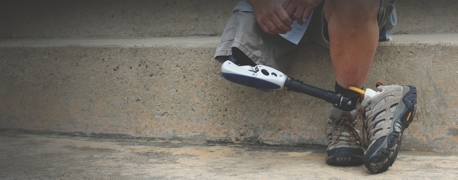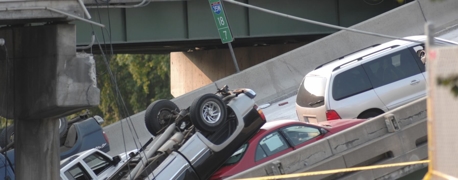Neighborhood Hazards Part 2: Ongoing Risks & New Threats

Parents typically worry about the big, obvious risks: speeding cars, strangers, and swimming pools. But what about the dangers no one warned you about—because they didn’t exist when we were kids, or because no one thought to speak up?
Today’s neighborhoods are full of modern hazards and overlooked threats. E-bike battery fires. Five-gallon buckets. Fireworks. Even an old, abandoned appliance like a refrigerator can turn into a fatal hazard for a curious toddler.
These risks don’t always look dangerous. They blend into everyday life. But every year, they’re responsible for catastrophic injuries and deaths among children—accidents that are all the more heartbreaking because they’re so often preventable.
Five-Gallon Buckets
They seem relatively harmless—just tools for cleaning or storing paint, water, or supplies. But five-gallon buckets are among the deadliest hidden hazards in the home and garage. Their height, weight, and narrow opening make it extremely difficult for small children to escape once they fall in.
According to the U.S. Consumer Product Safety Commission (CPSC), even with just a few inches of liquid inside, these buckets can become deadly drowning traps. A child leaning in to retrieve a toy or watch the water slosh can easily tip headfirst into the bucket—and if no one sees it happen, the outcome is often fatal. Most of these incidents involve toddlers under three.
As a result of an agreement between manufacturers and the CPSC, the vast majority of five-gallon buckets should now carry warning labels in English and Spanish. At the time the agreement was reached in 1995, an estimated 36 toddlers were drowning every year in five-gallon buckets. News releases and public service announcements were also created to inform the public of the risk, but these can still be found in neighborhoods across the country.
A few steps can help prevent drowning accidents involving five-gallon buckets:
- Never leave five-gallon buckets filled with liquid where a child can reach them.
- Store full five-gallon buckets with lids properly secured.
- Store empty buckets upside-down and out of sight.
Even a few inches of water can drown a child.
Fireworks
In the weeks around July 4th and New Year’s Eve, emergency rooms nationwide see a surge in fireworks-related injuries, many involving children. The CPSC reports that teens aged 15 to 19 and children aged 5 to 9 had the highest rates of emergency department-treated fireworks injuries in the weeks surrounding the 4th of July in 2023.
Common injuries include burns, lost fingers, facial trauma, and eye injuries. But the most dangerous incidents involve fireworks being mishandled or igniting unintentionally near children. Even sparklers, which may seem relatively safe, can burn at about 2,000 degrees Fahrenheit, hot enough to melt some metals. Sparks can cause burns or eye injuries, and touching a lit sparkler can cause third-degree burns.
Neighborhood fireworks may seem fun, but without proper safety measures, they can quickly turn tragic. Hazards can be minimized by:
- Preventing children from playing with or handling fireworks, including sparklers.
- Keeping a bucket of water or hose nearby.
- Only purchasing and using fireworks that are legal in the area.
- Lighting fireworks one at a time.
- Never picking up or attempting to relight failed fireworks.
- Following instructions and warning labels on fireworks.
Lithium Battery Fires
From e-bikes and hoverboards to scooters and even cordless tools, many neighborhood toys and devices are powered by rechargeable lithium-ion batteries. These batteries can overheat, explode, or catch fire if overcharged, damaged, or poorly manufactured.
Between January and November 2022 alone, there were at least 208 incidents of lithium-ion battery fires or overheating involving e-bikes, e-scooters, and hoverboards, resulting in at least 19 deaths and over 20 injuries. Hoverboards and e-scooters accounted for most of these cases.
The lithium battery danger is very real—these devices have been directly connected to catastrophic fires. For instance, in March 2017, a hoverboard ignited a house fire in Harrisburg, Pennsylvania, causing the deaths of a 2-year-old girl and her 10-year-old sister. Just a few months later, a townhome in Manchester Township was destroyed by a fire caused by the same brand of hoverboard. The CPSC warned consumers to stop charging and using LayZ Board hoverboards immediately. Since that time, many other brands of hoverboards have been recalled for posing fire and explosion risks as well as various fall and injury hazards.
To fight the rising threat, in April 2025, the CPSC proposed safety rules aimed at making lithium-ion batteries safer for e-bikes, scooters, hoverboards, and similar products. These rules would set standards for battery management systems, overheat protection, and tamper-resistant casings to help prevent explosions and fires.
Vacant Lots, Abandoned Buildings & Construction Sites
Vacant lots, abandoned buildings, and active construction sites can turn into dangerous traps for neighborhood children. These spaces often attract kids exploring or playing—places adults might hesitate to enter, but kids see as opportunities for adventure.
These locations share painful similarities: hidden hazards and minimal oversight. Rotting or damaged floors, exposed nails, unstable trenches, and manholes all pose grave risks. And under attractive nuisance laws, property owners are held accountable when these hazards injure children—even if kids enter a property without permission—because children often can’t recognize the danger.
In Flint, Michigan, a 16-year-old boy fell through the roof of a boarded-up abandoned school, landing three stories below. Fire officials remarked that such vacant buildings are well-known attractive nuisances for children, yet many remain unsecured. Another tragic incident involved two young children who were buried in a large hole at a home construction site. The cousins, aged six and seven, were playing in a residential area outside of Charlotte, North Carolina, when they climbed down into an excavation pit about 24 feet deep to retrieve a fallen toy. One of the dirt walls collapsed, burying the children. Neither survived.
A few steps can help protect children from these hazards:
- Make sure children know of the risks associated with construction sites and abandoned buildings, and discourage them from visiting these locations.
- Report unsecured sites, open pits, abandoned properties, or other hazards in your neighborhood to the proper authorities.
- Attend homeowners or neighborhood association meetings when possible and advocate for regular inspections and stronger enforcement.
Front Yard & Driveway Accidents
The front yard may feel like an extension of the home—a safe zone where children can ride bikes, play tag, or draw with chalk. But in reality, it’s one of the most dangerous areas for young kids, especially when it comes to vehicle and equipment-related accidents.
Backover incidents, where a driver doesn’t see a child behind the vehicle when reversing, are heartbreakingly common. About 50 children are backed over by vehicles each week in the United States, with children under the age of 5 at the highest risk. Most devastating of all? In the majority of these cases, the person behind the wheel is a parent or close family member. Large SUVs, trucks, and even sedans often have blind zones that make it nearly impossible to see a child directly behind the car.
But vehicles aren’t the only risk. Lawn mower accidents—especially those involving riding mowers—also happen in front yards and driveways.
Simple prevention steps can save lives:
- Keep young children indoors while mowing or moving vehicles.
- Always walk around the vehicle before backing out.
- Never assume a child will stay where you last saw them.
- Don’t allow kids to ride on or near lawn equipment—whether powered on or not.
Abandoned Appliances
An old refrigerator left on the curb. A discarded washing machine in an alley. A rusting freezer behind a garage. These items may seem like trash—but to a child, they can become deadly hiding spots.
Large, enclosed appliances pose one of the most dangerous and easily overlooked threats in residential areas. Curious children may climb inside an old fridge or freezer during play—only to find themselves trapped. Some older models lock automatically when closed, and even newer ones can be difficult to open from the inside. Without air circulation, a child inside can suffocate.
This isn’t just hypothetical. According to the CPSC, dozens of children have died in abandoned appliance accidents over the years—so many, in fact, that Congress passed the Refrigerator Safety Act, requiring manufacturers to make doors that can be opened from the inside. But countless unsafe appliances still exist in homes, garages, junkyards, and even as illegal curbside dump-offs.
In 2019, three children lost their lives after climbing into an unplugged chest freezer. Aged one, four, and six, the children were playing outside a northern Florida home when they climbed into the freezer and could not get out.
Preventive steps are straightforward but critical:
- Never leave large appliances outside unattended or unsecured.
- Remove doors or latches before placing them outside for disposal.
- Store unused appliances in locked or inaccessible areas.
- Report abandoned appliances to your local waste or code enforcement office.
Prevention & Accountability Go Hand in Hand
Landlords, neighbors, and city agencies must all do their part. When old appliances are dumped or left to decay near places where kids live and play, it’s not just a nuisance—it’s a life-threatening hazard.
It’s impossible to see every danger coming, but those responsible for creating or ignoring those dangers should be held accountable. When a child is injured because of a faulty battery, dangerous product, or neglected property, the law is clear: children don’t have the same judgment as adults. And the people or companies responsible for putting them in harm’s way must answer for that.
When oversight fails, parents deserve accountability, transparency, and safer neighborhoods for their kids.


